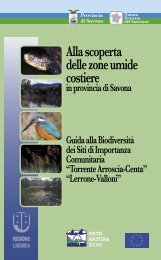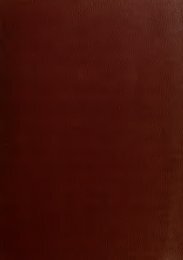Catalog of species-group names of Recent and fossil Scaphopoda ...
Catalog of species-group names of Recent and fossil Scaphopoda ...
Catalog of species-group names of Recent and fossil Scaphopoda ...
Create successful ePaper yourself
Turn your PDF publications into a flip-book with our unique Google optimized e-Paper software.
Species-<strong>group</strong> <strong>names</strong> <strong>of</strong> <strong>Scaphopoda</strong> (Mollusca)Sowerby, 1829 may be a senior synonym for this<strong>species</strong> (fide Dell 1957: 564).† zephyrinum, Dentalium Casey, 1903: 267.Oligocene. Red Bluff, Mississippi, USA. LectotypeUSNM Paleobiology 481672 (designated byMacNeil & Dockery 1984: 247, as “holotype”).† zingulai, Cadulus (Gadila) Hodgkinson, 1974: 18, textfig.8v, w; pl. 1, fig. 11, pl. 2, fig. 6a, b. Middle Eocene,Claibornian Stage, Cook Mountain Formation,Wheelock Member. Little Brazos Bluff, Brazos RiverValley, Brazos County, Texas, USA. Holotype USNMPaleobiology 180435; paratypes USNM Paleobiology180447, PRI 29227, ANSP 31505.zonatum, Dentalium “Orb.” Paetel, 1888: 594. “Jam.”[= Jamaica]. Nomen nudum. Remark: Pilsbry &Sharp (1898: 253) stated that this <strong>species</strong> “isunknown to us”.zonatus, Cadulus (Gadila) Boissevain, 1906: 74, pl. 6,fig. 57, text-fig. 37. <strong>Recent</strong>. B<strong>and</strong>a Sea, Indonesia,Siboga stn 214, 06°30’S, 121°55’E, 2796 m.Lectotype ZMA 3.06.102 (designated by Scarabino1995: 358) ; paralectotype ZMA 3.06.103(1; Arafura Sea, Siboga stn 254, 05°40’S, 132°26’E,310 m). Gadila zonata (Boissevain, 1906) (fideScarabino 1995: 358). Indo-Pacific: Indonesia toPhilippines. 195-2796 m.OTHER TAXA DESCRIBEDAS SCAPHOPODAThe list <strong>of</strong> non-scaphopod <strong>species</strong> erroneouslydescribed or assigned to this class, as compiled byPilsbry & Sharp (1898) is reproduced here, supplementedby <strong>names</strong> subsequently removed fromthe <strong>Recent</strong> <strong>Scaphopoda</strong>. We have included thetype <strong>species</strong> <strong>of</strong> the six genera – Entalium, Falcula,Hamulus, Pharetrium, Pyrgopolon <strong>and</strong> Spirodentaliumthat Pilsbry & Sharp (1898: 244-247)excluded from the <strong>Scaphopoda</strong>. However, wehave not included any <strong>species</strong> that were subsequentlydescribed in those six genera, since theydo not enter into homonymy with valid taxa <strong>of</strong>the <strong>Scaphopoda</strong>. The entry form is that <strong>of</strong> the list<strong>of</strong> genus-<strong>group</strong> <strong>and</strong> <strong>Recent</strong> <strong>species</strong>-<strong>group</strong> <strong>names</strong>.Detailed information on type localities, typematerial deposits <strong>and</strong> synonymy is only providedfor the <strong>names</strong> removed from <strong>Scaphopoda</strong> subsequentto Pilsbry & Sharp (1898).abbreviatum, Dentalium Deshayes, 1825: 352,pl. xviii, figs 21, 22 (“1864”: 199, pl. 3, figs 5-7).Eocene <strong>of</strong> Paris. “Serpula” heptagona Sowerby (fidePilsbry & Sharp 1898: 241) (Polychaeta).aciculatum, Dentalium Hall, 1860: 107. MiddleDevonian, Marcellus Shale <strong>and</strong> Portage Groups.Manilus, New York, USA. Coleolus aciculatus, transferredto Coleolus (phylum uncertain) by Hall(1879: 190), but it may as likely be a scaphopod(fide Pilsbry & Sharp 1898: 240).acus, Dentalium Eichwald, 1857: 584. Silurian[“Grauwacke”]. Putilowa [Poulkovo], near StPetersbourg, Russia; near Erras, Estonia.Criconarida (Cephalopoda: Mollusca) (fide Kiselev2001). Remarks: figured by Eichwald, 1860: 1062,pl. 40, fig. 10. Koken (1897: 214) remarked thatEichwald’s illustration showed an unusual irregularityin its curvature (“eine Unregelmässigkeit in derBiegung”), <strong>and</strong> questioned whether this <strong>species</strong> wasreferable to the <strong>Scaphopoda</strong>. Kiselev (2001) concludedthat this <strong>species</strong> was actually from theOrdovician, <strong>and</strong> belongs to the Cephalopoda.annulata, Dentalium McClell<strong>and</strong>, 1834: 629, pl. 35,figs 1-4. Ponar River, Kamaon, northern India.Remark: the biological nature <strong>of</strong> this taxon, whichappears to be a trace <strong>fossil</strong>, cannot be determined.annulatum, Dentalium Jay, 1850: 96 [ex Mighels MS]non Dentalium annulatum Gmelin, 1791. “Maine”.Nomen nudum. Remarks: Pilsbry & Sharp (1898:240) suggested that this taxon might be a Caecum(Gastropoda). We know <strong>of</strong> no basis for suggestingthat a nomen nudum could be referable to a knowngenus.antiquum, Dentalium Goldfuss, 1841: 2, pl. 166,fig. 2. Devonian? Eifel Mountain, Germany.Coleolus antiquum (Goldfuss, 1841) (fide Yochelson2002). Yochelson (2002) concluded that this<strong>species</strong> was not a scaphopod, <strong>and</strong> suggested that itbe referred to Coleolus Hall, a calcareous “worm”tube.arietinum, Dentalium Müller, 1776: 236. Ditrupa arietina(Müller) (Polychaeta) (fide Pilsbry & Sharp1898: 242).beachportensis, Tesseracme Cotton & Ludbrook, 1938:220, pl. 12, fig. 2. Off Beachport, South Australia,201 m. Holotype SAM D 13339. Pennatulidrhachis (Cnidaria) (fide Lamprell & Healy 1998:172).belcheri, Prodentalium Nassichuk & Hodgkinson,1976: 1153-1156, pl. 1, figs 1-9. Early Permian,Assistance Formation. GSC Locality 246406, LyallRiver, Grinnell Peninsula, Devon Isl<strong>and</strong>, ArcticOcean, Canada. Holotype GSC 1377; numerousparatypes GSC 13776, 44794-44797 (Polychaeta?).Remark: Yancey (1978: 306) stated that this <strong>species</strong>“is not a <strong>species</strong> <strong>of</strong> Prodentalium, <strong>and</strong> probably nota scaphopod” <strong>and</strong> concluded that “it is probablethat it is not a molluscan <strong>species</strong>, but a calcareousworm tube”.billingsi, Salterella Safford, 1869: 289. Ordovician <strong>of</strong>Tennessee. Transferred to the <strong>Scaphopoda</strong> byZOOSYSTEMA • 2004 • 26 (4)665




